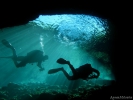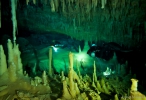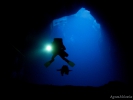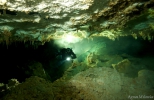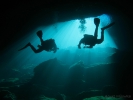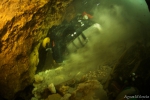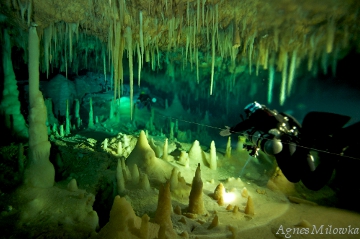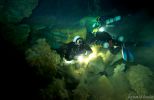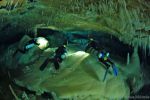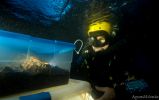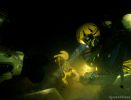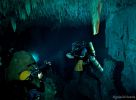Unravelling the mysteries of the Bahamas. |
 |
 |
|
As we flew over Abaco I asked the pilot ‘So what does everyone think of when they think of the Bahamas?’ ‘Sex on the beach’ he said without any hesitation... I can only assume he meant the cocktail. Either way it all sounded rather promising. I’ve been getting spoiled rotten over the past year living and diving in Florida’s cave country and one would think that I’d be rather hard to please after this experience. Yet the Bahamas did more than just please me; they titillated me, intrigued me and eventually left me breathless. While everyone is always going on about the Mexico caves, little did I know that not far off the Floridian coast, nothing short of a secret treasure exists… somehow the Bahamas had gone under my radar. But alas, we weren’t heading to the Bahamas to drink pina coladas and swing around in a hammock, we were on an expedition led by PhD Kenny Broad, to unravel some of the mysteries that lay within the Blue Holes of Abaco. Joining the team were everyone from palaeontologists, biologist to microbiologist and climatologist. Jenn Macalady, PhD Tom Iliffe, PhD Richard Franz, PhD Gary Morgan and Tom Morris... the list of scientists reads rather like the who’s who of the cave scientific research world. What’s more Wes Skiles and the Karst Production crew were there to document the goings on of the trip and immortalize the work of the divers and the discoveries of the scientists with film and still photography. I was in Ag heaven as Wes kindly allowed me to play with the big boys toys. The Nikon D-700 was amazing and produced incredible images; it is fair to say that it kicks ass all over my little point-and-shoot and that I now desperately want one. We didn’t come to the Bahamas just for the sake of blowing bubbles, we came to dive for a purpose… and this experience more than anything before brought home the message that caves are more than just a playground for divers. All too often a cave is seen as nothing more than a hole in the ground that divers can penetrate and then sit around bragging to their mates about how far they got. Cave divers, generally speaking, float around enjoying themselves and have little appreciation for what they are looking at beyond the aesthetically pleasing beauty that surrounds them. Scientists, given the same opportunities as us to see what is down there, would have kittens of excitement. Despite the caves being right there below our feet, we know so little about them. Our understanding of karst development, hydrology and cave biology is still in its infancy. To this day very few scientists are cave divers and as such a synergy between cave divers and scientists is essential. Thus we got the opportunity to get wet and check out the caves, and in between going ‘ooohhh… ahhh’ we brought back valuable data that has huge potential for the work of the scientists. I found it incredibly rewarding to combine doing something I love with a firm scientific purpose. One of the best dives of the project, and possibly one of the best dives I have ever done, was a recovery of the now extinct tortise shell and crocodile skull. Both were a cool 3000 years old and were recovered in faultless condition - perfectly intact! This was possible because of the special environment within Sawmill Sink and the thick layer of sulphur that blankets the hole at about 9m. A number of things happen as you swim into it. First watching a diver go in is like watching a magic trick. The diver suddenly disappears and leaves in their wake swirls akin to fog. As you enter the layer yourself all vision comes to a screeching halt, a total wipe out in visibility. All perception of where you are disappears… a perfect confusion of the senses. Suddenly you smell it! Yep you actually smell it underwater and it is almost as unpleasant as taking a deep whiff of undergarments after a few days diving. What actually happens is that your body absorbs this stuff, it permeates through your skin… makes me feel kinda dirty just thinking about it. Even after you pop out into clear dark water beneath the sulfur layer the smell stays with you. The visuals are spectacular, the experience is uncanny even if it does smell a little off, but what is really fascinating is the fact that this sulfur layer keeps the water below it in an anaerobic state. That means no oxygen is getting through that thick layer of sulfur and into the bowels of the cave. This got our microbiologist Jenn Macalady incredibly excited. The environment simulates that of the Earth’s surface many millions of years ago, which means that bacteria that are long extinct elsewhere are thriving here in Sawmill Sink. By studying them we can begin to grasp what life on earth used to be like. The sulfur layer and lack of oxygen have further consequences. Anything that has fallen into the sink throughout its existence remains perfectly preserved, especially as it slowly gets buried in the muck, commonly referred to as peat. It was incredible to see a tortoise shell that could very well have fallen in only yesterday, were it not for the fact that they have been extinct on Abaco for hundreds of years. Each individual piece of the shell was in place and many of the extraneous bones were still there. The dive itself was gnarly as hell, a whole team of divers trying to light up the recovery sequence. The silt was raining down on us from the slope, percolation was coming down on us from the ceiling, not to mention the mess that comes with excavation. The feeling of accomplishment when the remains made it safely into the container was great. Then there was the pure thrill when the boxes and the remains made it to the surface and into the arms of the eager and ever waiting scientists. Their eyes lit up the moment they saw the remains - they had seen nothing quite like this specimen. The excitement of Dick Franz and Gary Morgan was thrilling to watch as the possibilities for the knowledge gained from this recovery are infinite. Capturing this moment on camera meant that many others will be able to experience the joy they felt. There is more inside caves then bones of long dead animals however. Working beside a cave animal lover like Tom Iliffe and watching the man do his thing has opened my eyes to new possibilities. Each of these caves is an intricate, unique and self contained eco system. I enjoy watching crawlies and catfish in the caves, but beyond the obvious are a whole bunch of much smaller little dudes. The naked eye of your typical cave diver is not trained to spot these little guys, but Tom Iliffe has been doing this for over 30 years and in this time has found over 300 new species. Now I’m no scientist, but finding one new species is typically a lifetime achievement for a biologist. So the doctor has been most efficient and his track record is rather impressive. If nothing else this demonstrates rather neatly that the underground world really is the final frontier and we have much to learn and discover. The animals that Tom Iliffe does find can be appreciated in the water column if you have a good set of eyes. As apparently I don’t, I had to wait to see the intricate detail and beauty of the animals until they were in a vial and under the microscope. They were translucent, colourful, fragile and captivating in their moves and sheer beauty. Remipedes and worms... animals so wild looking and yet so cute I wanted to keep them as pets. The wildest human imagination could not conceive these creatures... they must have inspired so many science fiction writers. So keep your eyes open and peeled straight into the water column, you never know, that little white dot might be an incredible creature rather then just a speck of silt. While I don’t pretend to understand the nuances of the work the scientist were doing, I can certainly appreciate it. The data the team collected will help improve knowledge and understanding of caves in the Bahamas and around the world. More knowledge can only increase the importance these cave environments and eco systems have. Perhaps this can have a positive influence on how folks, cave divers and non-divers alike, perceive what is just below the surface of the earth. Yet, at the end of the day I am a cave diver and as far as I’m concerned the pursuit of extraordinary beauty is a perfectly legitimate quest. The team, spearheaded by Brian Kakuk, headed to a couple of beautiful caves called Dan’s and Ralph’s to photograph and film them. Dan’s was my first opportunity to see speleothems underwater, and oh boy, did I get spoiled. I was blown away to put it mildly. The sheer amount of decoration was incredible; there was room after room of decorations. Yet each room was very different and had a wildly distinct feel. My favourite was called the Alleyway, where I got to swim though a passageway with tall stalactites and stalagmites on either side of me, it felt like I was swimming through a giant crystal forest. The whole scene was illuminated from all sides by the ever powerful Dive Rite 50W lights, meaning I could see everything - amazing! Further Dan’s, like all the caves, has a number of life forms. I do believe I might have clapped my hands in excitement when I saw my very first Lucifuga. It is a fish, with a face only a mother could love that screams Jurassic. It is the oldest and the only truly cave adapted fish in the world. This little creature is just wickedly cool. I thought Dan’s was the best cave in the world until I dove Ralph’s. This cave defies description, it is probably the prettiest and most special cave on the planet. I could happily dive this cave every day for the rest of my life and not get bored with it. After you dive it, you seriously consider never setting foot inside a cave again, or perhaps simply lying down to die, because nothing will ever beat this experience. Every type of crystal decoration imaginable is present in this cave; intricate rose like formations, exquisite crystals, stalactites piled on so thick not even a flathead could swim through them without making contact. Then there were the soda straws with little diamond shaped crystals at the tips. They say diamonds are forever, well, this cave has captured my heart big time. I felt as fuzzy as the halocline that surrounded us as we explored and photographed the cave. Brian Kakuk runs Bahamas Underground and he was our illustrious guide throughout the trip. Not only is this man a genuine explorer with extensive knowledge of the local area, he is also a fabulous host and perhaps most importantly a top bloke. He deserves a medal for looking after our lot, taking us to orgasm-inducing caves… and for the late nights he stayed up filling all our tanks. A big thank you must also go to Nancy Albury and the Friends of the Environment; without their support, patience and hospitality we would have been completely lost. So, when I think of the Bahamas, I think of the most incredible caves in the world; a place where each cave is different, unique and startling. I think of fascinating scientific work and of all the questions the scientists are attempting to solve. I think of fossils, bones and the oldest living fish in the world. I think of a beautiful rugged coastline. I think of sunsets and the sweet taste of a well deserved beer at the end of the day. But I do not think of sex on the beach. Somehow, to my great dismay, the Bahamas stereotype managed to elude me. Still, one can’t have everything… and there is always next time.
|
